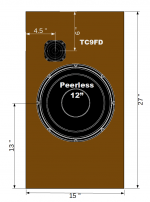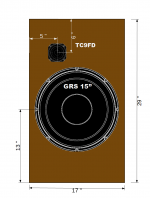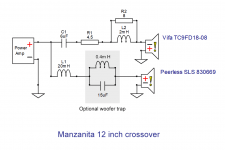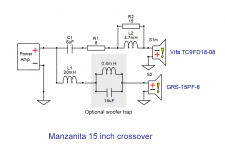Wings on the back.
If you need to keep the baffle narrow, the side wings can be installed behind the baffle, saving 1.5 inches in width. The wings will not be visible from the front. This works well, but wings on the sides is a little better and is the default choice. See below for this style of build.
If you need to keep the baffle narrow, the side wings can be installed behind the baffle, saving 1.5 inches in width. The wings will not be visible from the front. This works well, but wings on the sides is a little better and is the default choice. See below for this style of build.
Attachments
The Manzanita Crossover
Here we have the simple and clever crossover that makes this OB speaker work. See below for the 12 and 15 inch versions. Actually, either crossover will work with either woofer, but the versions below have been tweaked for best performance with the different woofers. The big piece is the low pass inductor on the woofer. It can be 18-22mH, default 20mH. Use a 14 or 16 gauge iron core inductor. This is available from Erse, Madisound or Parts Express in the USA. This part is relatively expensive, but important to the design. Default part at the moment is Parts Express P/N 266-960 (16 ga. 20 MH)
Capacitor C1 is the high pass filter for the Vifa. R1 is attenuation for the Vifa, while R2 and L2 shape the top end response of the Vifa. Tune the value of R1 to raise or lower the overall output of the Vifa (mids and highs) and tune R2 to change just the levels of the Vifa highs. The tweaking/tuning range of R1 is usually 2:1 centered around the nominal value. R2 tuning range is the same 2:1 ratio around the nominal value. 5-10 watts is enough for these resistors. Default is capacitor is Parts Expres P/N 027-236. You can use 5.5 - 6.5 uF to suit. Look for 200 Volt or higher Poly, film and foil, MKP or Oil construction. NOTE: Connect the Vifa in reverse polarity.
Please be prepared to tweak and tune these values to suit your room acoustics and your speaker placement. The overall level as well as the slope of the Vifa response need to be tweaked for your situation. Take your time, start with the default and tune it for you room.
In series with the woofer will you see an optional woofer trap. This helps tame some come breakup of the woofer. It's a nice addition. The same trap works for either woofer.
EDIT: Now that these are posted, I will add some detail to the posts.
Here we have the simple and clever crossover that makes this OB speaker work. See below for the 12 and 15 inch versions. Actually, either crossover will work with either woofer, but the versions below have been tweaked for best performance with the different woofers. The big piece is the low pass inductor on the woofer. It can be 18-22mH, default 20mH. Use a 14 or 16 gauge iron core inductor. This is available from Erse, Madisound or Parts Express in the USA. This part is relatively expensive, but important to the design. Default part at the moment is Parts Express P/N 266-960 (16 ga. 20 MH)
Capacitor C1 is the high pass filter for the Vifa. R1 is attenuation for the Vifa, while R2 and L2 shape the top end response of the Vifa. Tune the value of R1 to raise or lower the overall output of the Vifa (mids and highs) and tune R2 to change just the levels of the Vifa highs. The tweaking/tuning range of R1 is usually 2:1 centered around the nominal value. R2 tuning range is the same 2:1 ratio around the nominal value. 5-10 watts is enough for these resistors. Default is capacitor is Parts Expres P/N 027-236. You can use 5.5 - 6.5 uF to suit. Look for 200 Volt or higher Poly, film and foil, MKP or Oil construction. NOTE: Connect the Vifa in reverse polarity.
Please be prepared to tweak and tune these values to suit your room acoustics and your speaker placement. The overall level as well as the slope of the Vifa response need to be tweaked for your situation. Take your time, start with the default and tune it for you room.
In series with the woofer will you see an optional woofer trap. This helps tame some come breakup of the woofer. It's a nice addition. The same trap works for either woofer.
EDIT: Now that these are posted, I will add some detail to the posts.
Attachments
Ultra with "Wings"?
John and/or Pano,
Looking back at post #1776, the additional wings look to be for the Manzanita, not the Ultra, am I correct? Would the same approach work for the Ultra, or is in just not needed due to the baffle size?
Thanks! 😀
John and/or Pano,
Looking back at post #1776, the additional wings look to be for the Manzanita, not the Ultra, am I correct? Would the same approach work for the Ultra, or is in just not needed due to the baffle size?
Thanks! 😀
@Classrc. That is a more advanced build and not "officially" supported in this thread.
Of course you can use them, but unless John shares further details, you'll have to go off the info provided in that post. This gets into H-Frame territory.
Of course you can use them, but unless John shares further details, you'll have to go off the info provided in that post. This gets into H-Frame territory.
Hello Chris.... welcome to the OB world... I assume you are talking about a book shelf up against a wall or that has a solid back. In that case, OB can only work at higher frequencies, say 500 Hz or so. And then, it is actually more of an infinite baffle than an OB. However, there are book shelves that exstend out into a room, think library, that are well away from a wall, and have access from both sides. Then an OB can work. What exactly is your situation? J
John – that was my hunch, but I wanted to ask the cognoscenti 🙂
My situation is a traditional closed-back bookshelf. I had a vision of a sort of floating baffle nicely centered on a shelf with a 1" reveal around the baffle. Maybe best to try this with a front ported traditional design.
Minor correction for post 2502
The first part of paragraph two should read: "Capacitor C1 is the HIGH pass filter for the Vifa". Just FYI. J
The first part of paragraph two should read: "Capacitor C1 is the HIGH pass filter for the Vifa". Just FYI. J
Pano,
Great update and overall summary in #2502. Saves going back to try to find similar information spread across several much older posts. Makes it a lot easier to do the build now.
Thanks very much for the time and effort you put in to do this update.
Great update and overall summary in #2502. Saves going back to try to find similar information spread across several much older posts. Makes it a lot easier to do the build now.
Thanks very much for the time and effort you put in to do this update.
Last edited:
You're welcome! It had been difficult for all of us to find the up to date info in 2500 posts over 13 years. 😀
Just remember, the latest up to date info will be linked from the top of Post #1.
If I get motivated, I might try a sort of index of the thread.
Just remember, the latest up to date info will be linked from the top of Post #1.
If I get motivated, I might try a sort of index of the thread.
Maybe one more question that can be included in the tutorial:
Is it possible to slightly tilt the baffle? A slight tilt looks better, but what about acoustic phase?
Is it possible to slightly tilt the baffle? A slight tilt looks better, but what about acoustic phase?
Darnit. I built it based off of the old sticky that stated the xovers were the same. Gonna have to buy some components for the trap, etc. and try these out down the road. An excuse to play!
LOL. It a simple design that is fun to play with. You can learn a good bit just tuning it.
Yes you can tilt the baffle a little. Bear in mind that it is designed for a 90 degree baffle, but the design is forgiving. The crossover point is fairly low, thus longer wavelengths and less critical depth issues than a design crossing an octave or two higher. Also remember that the Vifa can be a little bright directly on axis, so you may need to adjust toe-in and /or the crossover.
Yes you can tilt the baffle a little. Bear in mind that it is designed for a 90 degree baffle, but the design is forgiving. The crossover point is fairly low, thus longer wavelengths and less critical depth issues than a design crossing an octave or two higher. Also remember that the Vifa can be a little bright directly on axis, so you may need to adjust toe-in and /or the crossover.
Pano, what do think about rounding over the edges of the baffle. Let's say with a 3/4" radius. Good idea or not?
I'm thinking of doing it as much for the appearance as for the sound. Maybe even more so for the aesthetics.
Theoretically it should make the sound a little better. But I just want to make sure it won't compromise the sound in some obscure way that I didn't anticipate.
Thanks for your feedback.
Theoretically it should make the sound a little better. But I just want to make sure it won't compromise the sound in some obscure way that I didn't anticipate.
Thanks for your feedback.
Hello, I'm planning to try my first DIY project and build the Manzanita "classic", but I wasn't able to find wich is the difference using the 12" or the 15" driver version, apart of the price difference of the two drivers, for what reasons I should chose one or the other?
The Peerless 12" had gone way up in price at one point, so an alternate woofer was found. The GRS is perfect for this project and the bigger woofer means the speaker is a little more efficient. It should play a little lower than the 12.
That said, the Peerless is a superb driver and really sounds nice. I love them.
That said, the Peerless is a superb driver and really sounds nice. I love them.
I understood that for the philosophy of the project was found another driver, and the GRS costs less than half the Peerless, but still is not a crazy amount of money of difference, so it is worth the price difference or the difference between the two is barely audible?
- Home
- Loudspeakers
- Multi-Way
- Fast, fun, Inexpensive OB project




